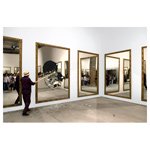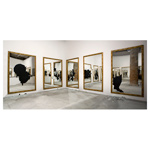At the opening ceremony of the Venice Biennale in 2009 Pistoletto presented the action and installation Twenty-Two Less Two. Along the walls of a large room located at the beginning of the route through the Arsenale were placed 22 large mirrors measuring 3 by 2 meters and set in gilt frames. In front of a crowd of visitors and photographers recording the action, and who were reflected in their turn in the mirrors, Pistoletto started to strike and shatter the mirrors with a large hammer, creating large black holes of different shapes on their surfaces. At the end of the action the mirrors and the broken pieces that had fallen onto the floor were left on display as an installation. The relationship that was created in each shattered mirror between the remaining reflective surface and the black one produced by the breakage proposed once again the dynamic between reflective surface and photographic image in the Mirror Paintings, turning them into a sort of abstract version of those works. The reflections between the mirrors and to an even greater extent the ones produced between the innumerable fragments resulting from the breakage represented on the other hand a further development of the research initiated in 1978 with the works of the series Division and Multiplication of the Mirror.
Pistoletto has staged similar performances and made similar installations on other occasions, in some cases entrusting the act of breaking the mirrors to others, as happened for example with Seventeen Less One, the first work in this series, presented at the Yokohama Triennale in 2008 and acquired by the Museum of Modern Art in New York both as an action and as an installation. The Museo Nacional de Bellas Artes in Havana has in its permanent collection the installation Thirteen Less One, in this case created personally by Pistoletto in 2015 in the spaces of the museum.
“In the mirror painting we have a fixed photographic image, one that does not change but coexists with the present that is continually changing. [...] In Venice the mirror was alone, without a fixed figure, that is to say without memory, a present that expanded ad infinitum. This present needed memory. By “smashing” the mirror, I introduced into it an element, the black that lay behind. It instantly assumed a fixed form that had the same value as the photograph. The work documents an act that has been the present and remains as memory: a gestural photograph.”
(M. Pistoletto interviewed by E. Milesi, Lo storico del presente, “Art app”, no. 3 [Bergamo, 2010].)
“The breaking of the mirror can be interpreted in many ways. The first belongs to the realm of superstition: the idea that breaking a mirror brings bad luck is a very persistent fear, as the mirror is thought to have magical powers. So by shattering the mirror, I shatter the superstition too. The second concerns the physical reality of the mirror. I break its material substance, but at the same time I multiply the immaterial images it houses. The fragments are all different, but they all retain the reflectivity of the original mirror.”
(M. Pistoletto, interviewed by Marie-Laure Bernadac, in Michelangelo Pistoletto - Année 1, le Paradis sur Terre [Paris: Actes Sud/Louvre Editions, 2013], 33.)

